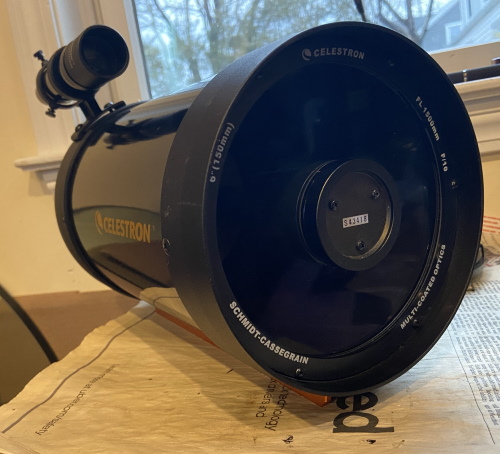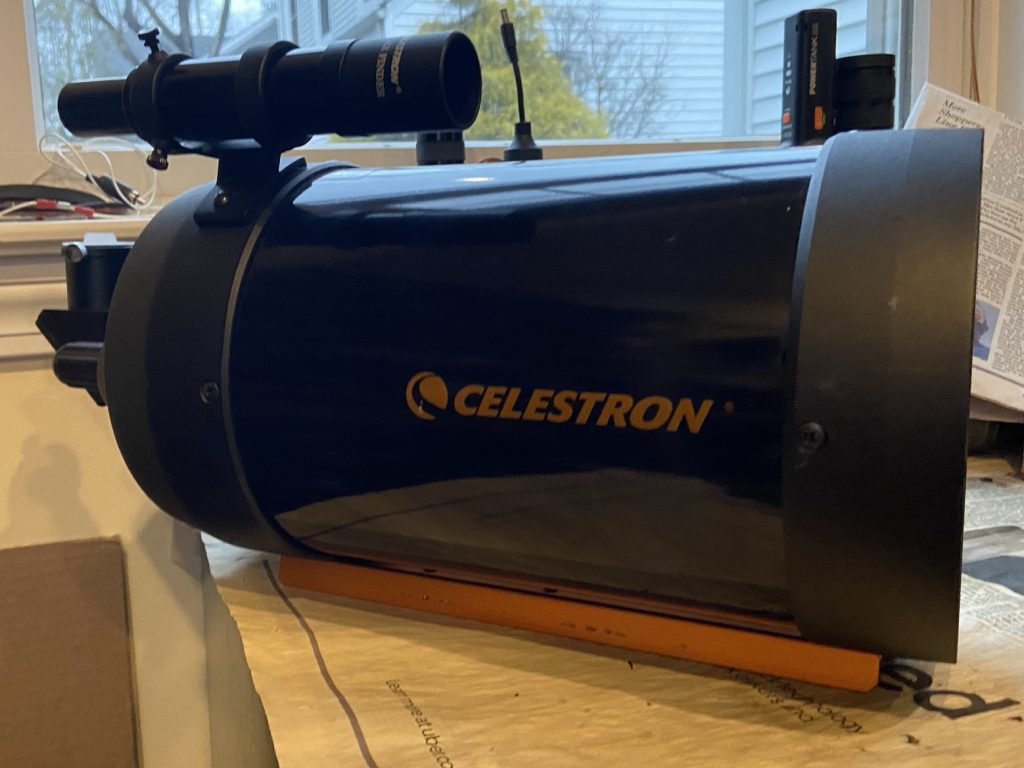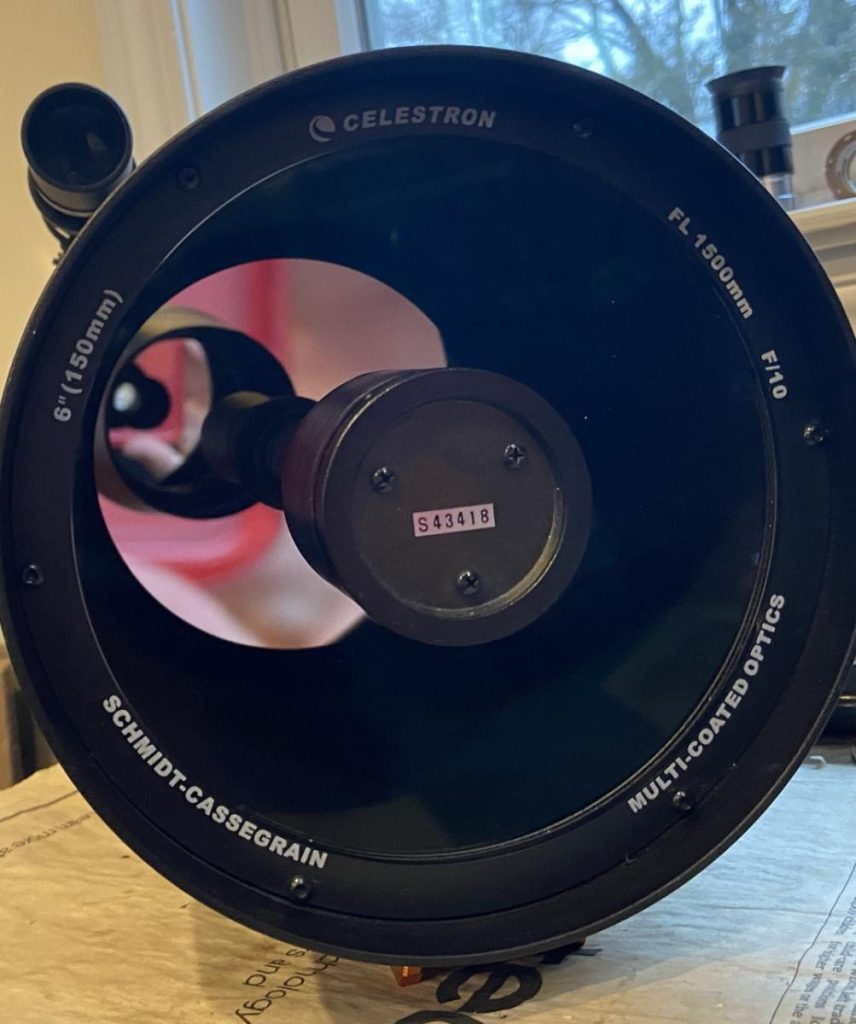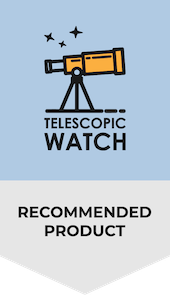The C6 Optical Tube



The Celestron C6 SCT VX GOTO package uses Celestron’s C6 XLT optical tube, a 6” (150mm) f/10 Schmidt-Cassegrain with a resulting focal length of 1500mm. The C6 XLT is the newest of Celestron’s Schmidt-Cassegrain telescopes and debuted in 2005. The C6 has never been sold in any configuration other than the XLT, though some of the older C6 XLT optical tubes are not compatible with the Starizona HyperStar system. The bottom of the telescope has a dovetail plate in the style of a Vixen, which makes it easy to connect to almost any astronomical mount or tripod. The C6 is marginally heavier and bulkier than the older C5, but features significantly better optical quality as well as more light-gathering and resolving power.
Like many other catadioptric telescopes, the C6 XLT uses a knob on the back of the telescope to focus the primary mirror by moving it backward and forward inside the tube. This can sometimes cause “image shift” when focusing, which is especially a problem at high magnification or when doing any kind of astronomical imaging. However, the C6 XLT suffers little from this issue, in part due to the minimal size and weight of the primary mirror.
Any Schmidt-Cassegrain telescope also requires regular collimation by adjusting the secondary mirror, but collimating the C6 XLT is a fairly quick and easy process, and you won’t have to do it every time you set it up. The C6 XLT has a standard threaded port at the back that allows for the use of Schmidt-Cassegrain accessories and adapters, such as an f/6.3 reducer. The small size of the interior baffling of the C6 XLT means that you will have vignetting problems if you use an f/6.3 reducer with a large camera sensor or for visual use; the same is true if you try a 2” diagonal. As such, the true field of view of the C6 XLT is limited to a hair over 1 degree in the sky—not very wide for a 6” telescope.
Like all of the newer Celestron Schmidt-Cassegrain telescopes apart from the C5, the Advanced C6 XLT has HyperStar compatibility, which allows you to remove the secondary mirror and install a Starizona HyperStar f/2 lens to use the telescope as a super-fast f/2 Schmidt camera with a 300mm focal length. However, the C6 XLT only works with relatively small sensors in its HyperStar configuration. This is due to both the physical sensor illumination constraints and the fact that a large camera housing can obstruct a significant portion of the telescope’s aperture.
Accessories
The Celestron C6 SCT VX GOTO package includes a 25mm, 1.25” E-Lux Plossl eyepiece, which provides a magnification of 60x with the C6 XLT. Its 52-degree apparent field of view translates to a 0.86-degree true field in conjunction with the C6 XLT, or a little less than twice the angular diameter of the full Moon in the sky. You’ll need additional eyepieces for higher magnifications, and a slightly lower-powered eyepiece to squeeze out a wider field of view for deep-sky objects might also be worth the investment.
You also get an excellent quality 1.25” prism star diagonal, a 1.25” visual back to insert the diagonal or a camera, and a 6×30 finder scope for aligning and aiming the telescope.
The Advanced VX Equatorial Mount
If you want a computerized German equatorial mount but don’t want to spend too much, the Celestron Advanced VX mount is a good choice. It has servo motors for slewing and can be connected to plug-in accessories like autoguiders and Celestron’s aftermarket add-ons like the StarSense AutoAlign, SkySync GPS, and SkyPortal WiFi adapter. It is suitable for visual astronomy or planetary imaging with telescopes weighing up to 30 lbs. and accepts Vixen-style and Celestron CGE-style dovetail plates.
While the Advanced VX can handle long-exposure astrophotography with a C6 telescope and f/6.3 reducer or f/2 HyperStar conversion, it is not the best choice for dedicated imaging purposes. The Sky-Watcher HEQ5 Pro or EQ6R would be a better option for such a task; either mount has superior gearing, and the EQ6R would be a lot more steady than the Advanced VX or HEQ5.
A single 11 lb counterweight is required to balance the Advanced VX with the C6 XLT and provides plenty of additional margin for heavy accessories such as eyepieces. The Advanced VX can be powered by either AC or DC connectors, but only a cigarette lighter DC cord is included by default. You can also use a MicroUSB cable to connect the mount to your PC and use software to control the mount directly through its ASCOM drivers or to update the controller’s firmware.
The Advanced VX mount is easy to set up and use, though there are more steps and moving parts than a simple alt-azimuth GoTo mount. First, you need to assemble the mount and install the counterweights and telescope. Then, you need to balance the telescope on both the right ascension and declination axes by sliding the tube and counterweights.
After putting together and balancing the C6 XLT for the first time on the Advanced VX, you can mark the dovetail on the telescope and the counterweight bar on the mount so you can remember where to put the counterweights and telescope tube for proper balance. After the telescope and mount are fully assembled, balanced, and leveled, you need to polar align the mount. This can be done with a polar scope or polar alignment system like a PoleMaster, either of which must be purchased separately. You can also use the Celestron All-Star Polar Align system for polar alignment, but this is more complicated. If you are not using All-Star Polar Align, there is no reason to power up the mount until it is properly polar aligned. After polar aligning and powering on the mount, you’ll need to input the date, time, and location and align the Advanced VX’s GoTo system on 2 or 3 alignment stars.
Provided you have perfectly leveled, aligned, and balanced the C6 XLT and Advanced VX, the mount is a rock-solid platform for the relatively small telescope placed atop. GoTo and tracking accuracy for visual use should be spot-on. However, inaccuracies can build up over time, which you can compensate for by using the Sync function on the mount to add additional alignment stars (or even whatever object you’re currently viewing) and re-calibrate the mount. The Advanced VX’s hand controller contains a database of some 40,000 objects, many of which are uninteresting or beyond the reach of the C6 visually.
Should I buy a Used Celestron C6 SCT VX GOTO?
If you have the opportunity to purchase a used Celestron C6 SCT VX GOTO package at a reasonable price, it can be a good investment as long as you thoroughly check the condition of the equipment. One thing to be cautious of is a broken front corrector plate, which cannot be repaired or replaced without also replacing the primary and secondary mirrors “matched” to it; this costs more than simply purchasing a new or used C6 XLT in working condition. It is also extremely important to ensure that both of the mirrors in the C6 XLT are free of significant corrosion, as recoating is similarly too expensive to bother with. Also, ensure the front corrector plate in the telescope is free of fungus, which can permanently damage the glass by chemically etching it.
On the other hand, a faulty Advanced VX mount can be replaced or repaired; if the mount head itself is non-functional, you can usually find a used mount head to place atop the tripod for much less than the cost of a full new set of a tripod, mount, and hand controller. A missing or broken hand controller is also fairly trivial to replace, along with counterweights or accessories like the finder, visual back, eyepiece, and star diagonal.
Alternative Recommendations
The Celestron C6 SCT VX GOTO is hardly the best deal in its price range, and you may want to consider a bigger telescope for visual use or buying an a la carte setup for imaging.
Under £800
- The StellaLyra 10″ f/5 Dobsonian features a significantly larger primary mirror, offering much higher resolution and light-gathering capabilities compared to the Celestron C6 SCT VX while still coming in at a lower cost and similar total assembled weight. It also comes with a wide range of high-quality accessories and features often skipped with many telescopes. The 8″ model is more affordable and a bit lighter than the 10” StellaLyra while including the same features/accessories but isn’t much more portable, taking up a similar amount of storage space.
- The Celestron StarSense Explorer 8” Dobsonian features a simple, sturdy, and easy-to-aim Dobsonian mount, aided by Celestron’s StarSense Explorer technology for night sky navigation. It’s also quite portable and easy to set up, allowing an adult to carry the entire telescope in one trip.
- The Sky-Watcher Virtuoso GTi 150P delivers the same overall performance as the C6 XLT, with fully motorized tracking and GoTo capabilities, allowing manual aiming and with a mount controlled via your smart device rather than with a hand controller. Its collapsible tube and mount occupy very little storage space when not in use, much like the C6 optical tube. The Heritage 150P is identical in specs, performance, and features to the GTi 150P, except for the absence of electronics.
- The Sky-Watcher Skymax 127 AZ-GTi offers the high-quality Skymax 127 Maksutov-Cassegrain optical tube atop the versatile AZ-GTi mount and tripod, a motorized tracking GoTo mount which can be pushed around the sky by hand or operated via your smartphone. The Skymax 127 Virtuoso GTi has the same features but on the Virtuoso GTi tabletop Dobsonian mount, though it can still be attached to a third-party tripod if you wish. The Skymax 127 optical tube has comparable performance to a 5-6” Newtonian or SCT on the planets and other bright targets but doesn’t need collimation adjustment.
£800-£1200
- The Celestron StarSense Explorer 10″ Dobsonian offers many of the same features and a similar form factor as the 8″ model but with additional aperture and simplified collimation, gaining only a little bit of weight and thus still remaining remarkably portable. The StarSense Explorer technology of course makes it a breeze to find “faint fuzzies” like nebulae and galaxies throughout the night sky without any motors or batteries, too.
- The Celestron NexStar 6SE shares the same C6 XLT optics and included visual accessories as the Celestron C6 SCT VX package, but is more portable, quicker to set up, and less expensive, while delivering the same performance apart from lacking deep-sky astrophotography capabilities.
Over £1200
- The Celestron NexStar Evolution 8 features Celestron’s C8 XLT optical tube with greater light-collecting and resolving power than a 6” scope but still remarkably compact in size. The NexStar Evolution mount offers fully motorized GoTo and tracking, as well as a built-in lithium battery and WiFi adapter for control via your smartphone/tablet at your convenience.
- The Sky-Watcher Explorer 200PDS NEQ6 Pro, an 8″ Newtonian reflector designed for astrophotography, is mounted on the high-quality NEQ6 Pro mount, making it an excellent option for those seeking a ready-to-use imaging setup. The NEQ6 Pro mount outperforms the Advanced VX with its higher payload capacity, more accurate tracking/guiding, stepper motor drives, and superior mechanical design.
- The Sky-Watcher Skyliner 300P FlexTube GoTo Dobsonian, with its 12” aperture, nicely bridges the gap between the massive 14-16” Dobsonians and smaller 8-10” GoTo telescopes, with the Sky-Watcher FreedomFind encoders allowing you to aim the telescope manually wherever you want and the FlexTube design helping to keep the scope fairly compact.
- The Sky-Watcher Skyliner 250P FlexTube GoTo Dobsonian is slightly more compact than a solid-tube 10″ Dobsonian and features fully motorized tracking and GoTo capabilities, controlled via your smartphone or tablet while still allowing for manual aiming of the telescope thanks to its FreedomFind encoders.
- The Celestron NexStar Evolution 6 includes the same mount and design features as the Evolution 8 but uses the C6 XLT optical tube like the Celestron C6 SCT VX. Considering the negligible difference in physical size due to the identical mount/tripod, we’d recommend opting for the Evolution 8 over the 6 if it’s within your budget. Otherwise, the NexStar 6SE or a larger Dobsonian are more economical alternatives.
Aftermarket Accessory Recommendations
The Celestron C6 SCT VX GOTO/C6 XLT package comes with very few accessories, making it essential to obtain some extra components and at least a couple of supplementary eyepieces to fully exploit this telescope’s potential and ensure the most pleasurable experience. A dew shield is indispensable for the C6 XLT or any Schmidt-Cassegrain telescope, as it minimises glare from nearby light sources entering the telescope, while also slowing down frost or dew formation on the C6 XLT’s front corrector plate and protecting against pollen, dirt, and dust accumulation, all of which can harm the delicate corrector and its coatings over time, as well as spoil your viewing experience.
A 1.25” 32mm Plossl eyepiece for 47x with the C6 XLT provides a slightly wider field of view and lower magnification than the provided 25mm Plossl, better for viewing deep-sky objects. A 2” star diagonal will vignette with the C6 XLT as will an f/6.3 reducer and low-power eyepieces, so there’s little point in obtaining either. For medium-high power, we recommend a 1.25”, 16mm UWA (94x) or 15mm redline/goldline (100x), while a 2x Barlow lens or a 7mm eyepiece such as a UWA or planetary (214x) provides fairly high magnification and close to the limit of what you can expect to typically use with the C6 XLT. A 10mm UWA (150x) or 9mm redline (167x) eyepiece may also be useful as well.
A UHC nebula filter can be attached to any of your eyepieces and enhances views of nebulae with the C6 XLT. Although the scope’s limited field of view is not well-suited for vast objects like the Veil Nebula, the filter assists in observing smaller objects such as the Orion or Crab Nebula by enhancing their contrast against the often bright sky background, which is particularly helpful under light-polluted conditions.
The Advanced VX mount, unlike most other quality GoTo equatorial mounts, does not come with a polar scope as standard, which can result in rough polar alignment using just the hole in the polar axis being both imprecise and exasperating if you are attempting imaging of any sort. The standard polar scope provided by Celestron is a suitable solution to this problem and much quicker than attempting to use the All-Star Polar Align feature. A DC power supply, like the Celestron PowerTank Lithium, is also necessary unless you can run the scope off an extension cord and AC power outlet.
What can you see?
A 6” telescope like the C6 XLT pales in comparison to a similarly-priced 8”, 10” or even 12” reflector when it comes to deep-sky viewing capabilities, particularly under light-polluted skies, which will limit what types of objects and details can be seen to begin with at any aperture. The limited field of view achievable with the C6 XLT, thanks to its long focal length and 1.25”-only accessories, also rules out observation of the largest open star clusters and nebulae.
However, even under so-so conditions with the C6 XLT, you can still have enjoyable views of medium-sized clusters like M35 and M38, as well as begin to resolve the brightest star clusters, such as M13, into individual stars. Planetary nebulae, such as the Cat’s Eye and Blinking Planetary nebulae, show slight details as well as greenish and bluish coloring, along with the larger but colorless Ring (M57) and the gigantic Dumbbell (M27). A UHC nebula filter serves to make planetary nebulae stand out at lower magnifications before taking a closer look at high power, as well as increase contrast on nebulae like Orion (M42) and the Lagoon (M8), which shine with a filter and/or dark skies, though they can be seen unfiltered as well. Thousands of double stars can also be split with the C6 XLT’s razor-sharp optics and are easily located in the Advanced VX mount’s database.
Dark skies are absolutely essential for viewing galaxies, and the C6 XLT can show high-contrast dust lanes in ones such as M64, M82, and M104, and begins to show hints of not-quite-resolved spiral arms in galaxies such as M51 at low magnification. You can also view many galaxy groups and clusters, the Virgo Cluster of galaxies chief among them with dozens of members.
The C6 XLT’s high-quality optics and long focal length make it ideal for planetary viewing, though its large central obstruction and small aperture are still limitations. Good collimation, allowing the telescope to cool to ambient nighttime temperatures, and stable atmospheric conditions are also essential for getting sharp views of the planets, lunar details, and other small targets. You can easily resolve the phases of Mercury and Venus, polar ice caps and dark surface features on Mars when it’s at its closest to us, and plenty of fine detail such as craterlets, mountains, and ridges on the Moon.
The C6 XLT can also show you the cloud belts, the Great Red Spot, and other atmospheric features of Jupiter, along with the disks and shadows of its four large moons, the Galilean moons, whenever they transit in front of the giant planet. The rings of Saturn, the Cassini Division in them, Saturn’s own dull cloud belts, and a handful of moons can be seen as well. The C6 XLT lacks the light-gathering power to show the moons of Uranus and Neptune and will have a hard time resolving the disks of either ice giant, while Pluto is beyond the reach of a 6” telescope owing to its dimness.
Astrophotography Capabilities
While the C6 XLT can be used for deep-sky astrophotography with the Advanced VX, assuming it’s reduced to f/6.3 and a suitable autoguider is used, you are pushing the limits of the mount and may run into vignetting or mirror flop issues with the telescope. A Starizona HyperStar will allow you to shoot with the C6 at 300mm focal length, which is hardly a problem for the Advanced VX even if it’s unguided. Though the HyperStar is expensive, and you are limited to using certain one-shot-color CMOS cameras with this configuration. An 8” RASA is a better choice if you want to shoot at f/2 and a similar focal length, or you could stick with a smaller refractor or Newtonian reflector astrograph designed for imaging.
Planetary imaging is best with an 8” or larger telescope with greater resolving power, but the C6 XLT can do a good job despite its limited resolution. You’ll want a 2x to 3x Barlow lens to boost the scope’s focal length to between 3000mm and 4500mm and achieve optimal image scale. Get out your laptop and plug in a high-speed planetary video camera (which also doubles as a guide camera should you decide to dabble in deep-sky imaging), and you can get great shots with the C6 XLT of the Moon, Venus, Mars, Jupiter, and Saturn from your backyard in just a few minutes of shooting under good seeing conditions and suitable processing of the footage later on.


